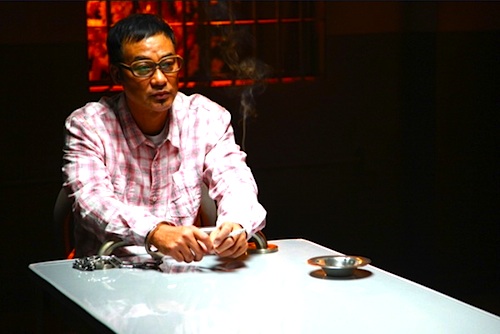By Joe Bendel. In a simple Chinese peasant’s world, no good deed goes unpunished. In the world of Chinese actor Chen Jianbin, a supporting cast-member’s drug bust can be used to cancel the release of his directorial debut. Arguably, their worlds are not as different as they might initially appear. However, one might well debate just who exactly is referred to in the title of Chen’s A Fool, which screens as an opening day selection of the 2015 New York Asian Film Festival, in advance of China Lion’s upcoming theatrical release.
Latiaozi is a salt-of-the-earth goat-herder, who is scrimping to get by after giving Li Datou, the village wheeler-dealer, a sizable bribe to facilitate his grown son’s release from prison. So far, Li’s lack of results makes things rather chilly for Latiaozi at home. The last thing he needs is an adult half-wit following him home like a stray dog. However, Latiaozi and his Muslim wife Jinzhizi are reluctant to turn him out into the cold, lest he freeze to death on their property.
As we might expect, the gruff couple warms to the idiot just about the time someone comes to claim him. For a while, Latiaozi takes satisfaction from his good deed until another group of self-proclaimed relations comes to claim the fool—and yet another. Each time the supposedly disappointed parties try to extort money from Latiaozi. It leaves the poor, unsophisticated rube in quite a state.

Chen’s A Fool arrives within the same festival season as Yuriy Bykov’s The Fool, exhibiting kinships beyond the similar title. While Bykov is more explicit in his criticism of Putin’s Russia, both films directly address the perils of being honest and guileless when living in the midst a corrupt system.
Pitiable Latiaozi does not stand a chance. Yet, his dogged earnestness exceeds all expectations. There is no question A Fool is a dark film, but it is not the proletarian passion play you might be expecting. Indeed, Chen is his own best asset. The standout from Doze Niu Chen-zer’s Paradise in Service and dozens of previous films, Chen plays Latiaozi as an achingly transparent everyman, incapable of deception and utterly overmatched by the wider world. Similarly earthy and direct, former television sex symbol Jiang Qinqin is shockingly glammed down and down-trodden looking as Jinzhizi. They completely feel like a husband and wife with a long shared history together (which, in fact, they are).
Unfortunately, Wang Xuebing’s drug-related incident was the pretext used to cancel A Fool’s Mainland theatrical distribution, but it is clear why Chen refused to reshoot his scenes with a different actor. Wang’s serpent-like charm and sarcastic edge are the X-factor that constantly kicks the film up yet another notch. Any other Li Datou would merely be a pale shadow of Wang.
The narrative of A Fool, based on Hu Xuewen’s novella, shares superficial commonalities with any number of propaganda tales about exploited peasants. Nevertheless, this is not didactic agitprop or a self-serving wallowing in the misery of others. This is a pointed yet pacey film that happens to hold a mirror up to reality while focusing on its rustic but sharply drawn characters. Highly recommended, especially for Chinese visitors to our fair city who might not otherwise have the opportunity to see it, A Fool screens this Friday (6/26) at the Walter Reade, kicking off this year’s NYAFF.
LFM GRADE: A
Posted on June 24th, 2015 at 5:47pm.






